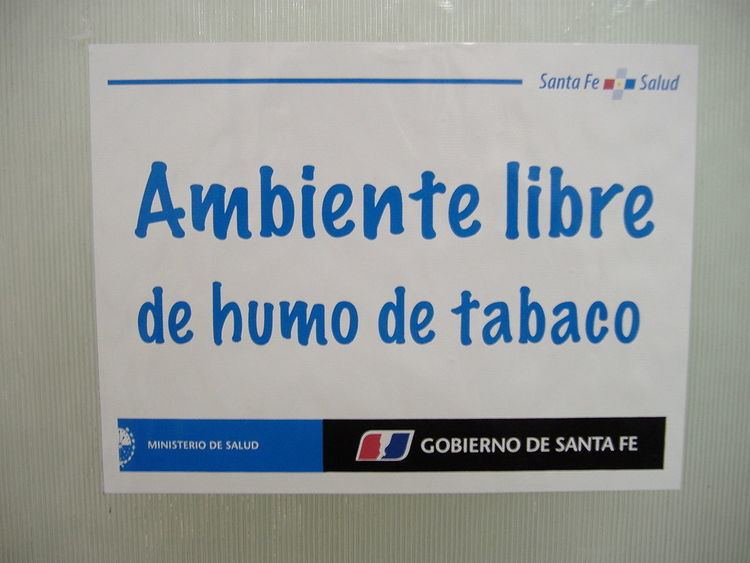 | ||
Smoking in Argentina accounts for 15% of total tobacco consumption in Latin America. There are a number of smoking restrictions in place in different jurisdictions, and a nationwide governmental campaign against tobacco smoking and advertising. Since June 1, 2011 a smoking ban in all of Argentina prohibits smoking in workplaces, all public indoor areas, schools, hospitals, museums and libraries, theatres, and all public transport.
Contents
- Law
- WHO Framework Convention
- Legislative deadlock
- Public sentiment
- Provincial and municipal laws on smoking
- References
The smoking percentage of the adult population of Argentina is not known; tobacco causes more than 100 deaths every day in Argentina (40,000 per year, 6,000 due to secondhand smoke), and the cost of the treatment of tobacco-related diseases amounts to 6020 million Argentine pesos ($1324 million USD) per year, 15.5% of the total public expenditure on health care. The government collects 3500 million pesos per year in taxes on cigarettes.
Law
National Law 23344, passed on 29 August 1986, established restrictions on advertising and promotion of tobacco, and dictated that cigarette packs must include a legend warning that Smoking is harmful to health, but did not include sanctions against violations of the law; these were added later, and then partially vetoed.
WHO Framework Convention
In September 2003 Argentina signed the WHO Framework Convention on Tobacco Control, though ratification was delayed by two years. Analysts blame tobacco industry interests for this delay, as with previous failures in implementing serious anti-smoking policies.
Legislative deadlock
As of 2006, a proposal to prohibit smoking in all public and enclosed spaces, sent by the Executive to the National Congress in August 2005, was awaiting consideration. Legislative lobbying from the tobacco industry proposed an alternative, weaker law, championed by Jujuy Province Senator Liliana Fellner, who called herself "the voice of the [tobacco] producers" (Jujuy is one of the seven tobacco-producing provinces in Argentina).
Public sentiment
A nationwide telephone survey published in August 2006 showed overwhelming support of the population for laws that establish "smoke-free spaces" in public spaces such as offices, factories, shopping malls and banks (93.4% overall support, 85% among smokers), and that completely forbid smoking in schools, universities and hospitals (97%). More than three quarters among the surveyed (including almost two thirds of the smokers) also supported smoking bans for bars and restaurants.
Provincial and municipal laws on smoking
In 2003, according to national sources, 75% of the Argentine provinces had some form of smoke-free legislation. Either in addition to or in the absence of provincial laws, many municipalities have local regulations to the same effect. Fines might be established for trespassers (tobacco companies, businesses and private individuals). The actual application of this legislation varies considerably.
